We thoroughly tested the Scott Patron 2025: the cutting edge of electric trail riding
The Scott Patron is probably one of the most striking and spectacular eBikes on the market. In 2025, it has been completely renewed, changing design concepts in search of an improvement in its performance, but maintaining those distinctive and futuristic lines characteristic of the brand. We have been able to test it thoroughly on our routes and trails and we tell you everything.
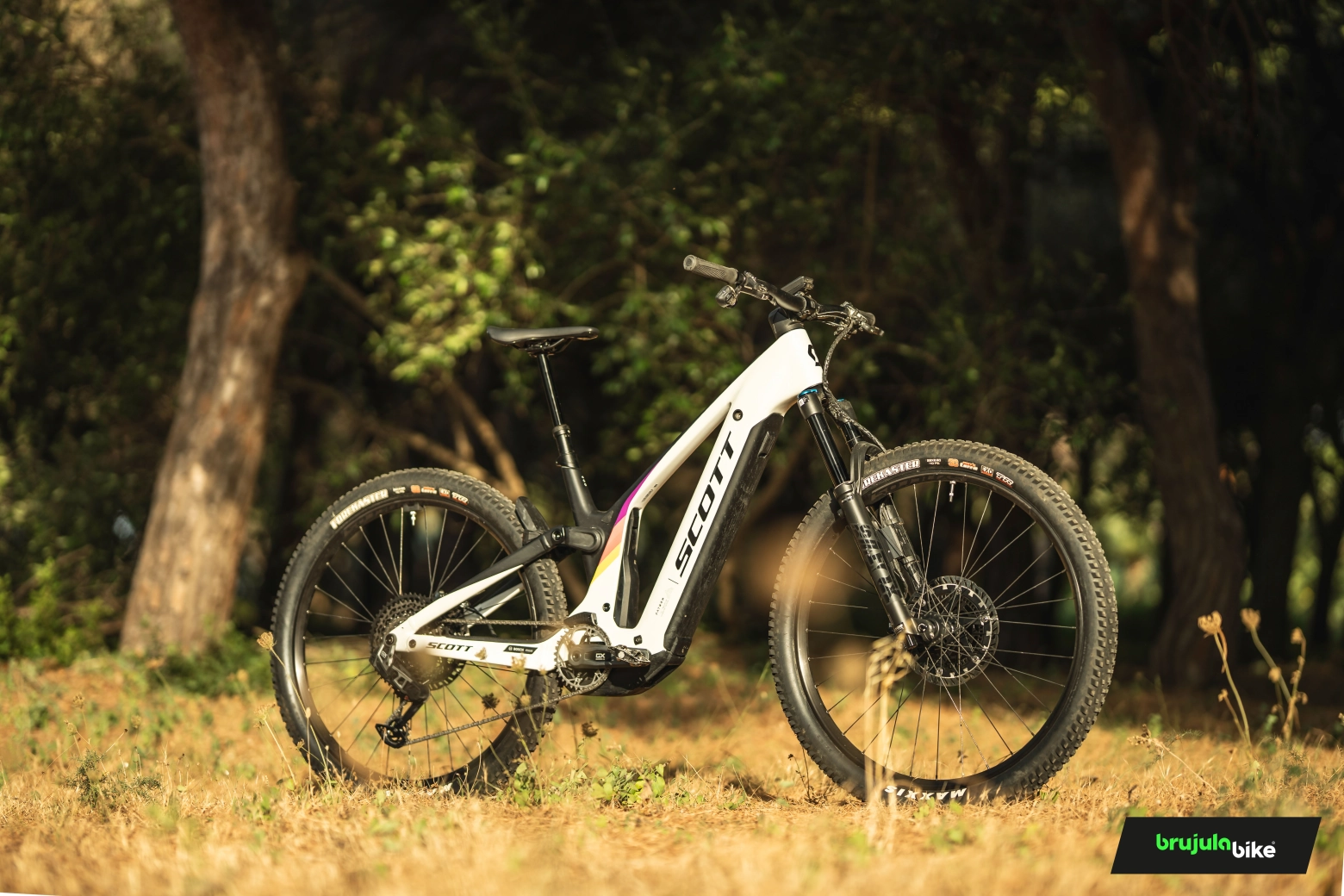
Scott Patron 2025: total renovation and unique character
Some time ago we were able to test the first version of the Scott Patron, a bike designed completely from scratch, not based on any muscular model, and that adopted all the integration concepts that have been marking a unique image in the brand. Well, in 2025, the Patron has undergone a profound redesign, but still maintains that integration and distinctive aesthetic line of Scott.
The most significant change in the new Patron is the relocation of the shock absorber and the motor. The shock absorber is now in a vertical position and placed very low. This is achieved, in part, thanks to the repositioning of the motor in a lower position, as it was previously rotated upwards, and to the fact of housing the shock absorber inside the frame, which allows finding that optimal position, both for its operation and for lowering the center of gravity to the maximum.
RECOMENDADO
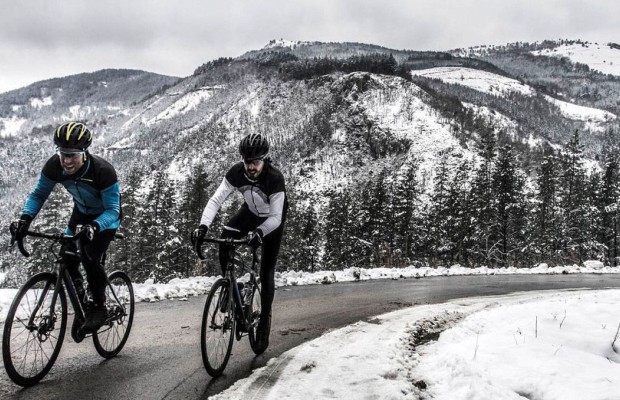
Cycling tips for the Christmas season

What would you do if you won the lottery? This cyclist bought himself a €20,000 bike
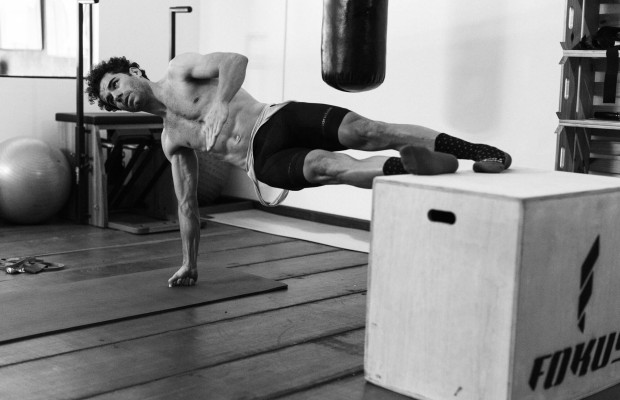
The best exercise routine to do at home
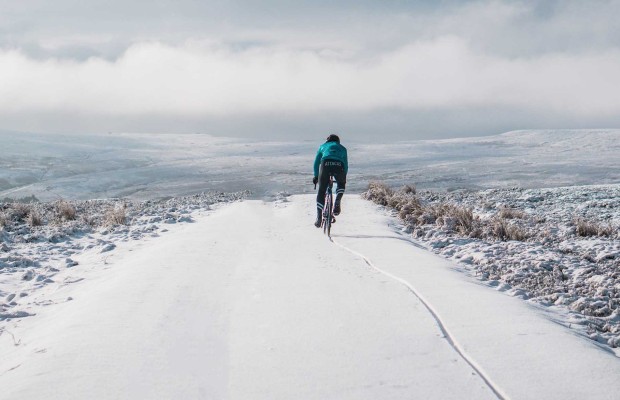
Benefits of training in the cold
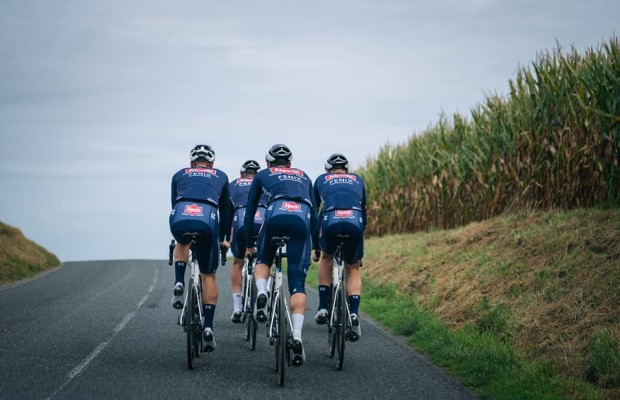
The cyclist's patience: how long, gentle training sessions build your best season

Tips for cycling in the rain
Now the Patron looks more streamlined and clearly highlights the low placement of its top tube, which will allow good freedom of movement.
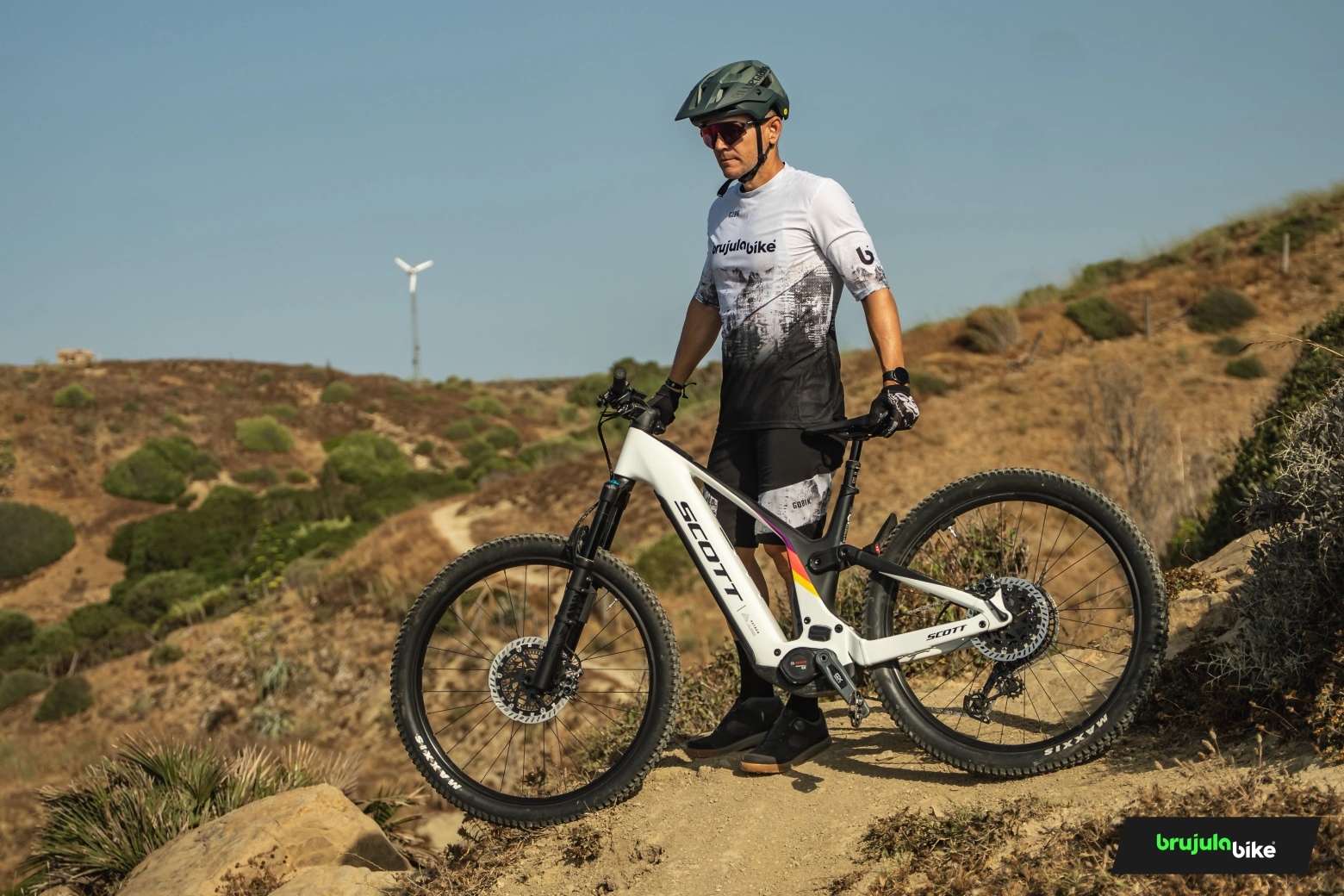
The Scott Patron range is divided into two versions: Patron and Patron ST. Both feature a frame with 150mm of rear travel, but the first one opts for a fork with the same travel and equipment more focused on light trail riding, while the ST version features a 170mm fork and equipment aimed at greater capabilities in challenging terrain.
The Patron's suspension system is of the 4-Bar type, with a pivot point on the chainstays but, as is customary in Scott, the link connecting to the shock absorber has an external part outside the frame and an internal part, concentrically connected to the pivot point. This internal part is what acts on the shock absorber, which is completely hidden from view. To access the shock absorber itself, whether for adjustment or disassembly tasks, we have a very well-designed cover that offers us complete access. This cover is removed simply by lifting a tab and is easily placed back with the help of magnets for proper placement.
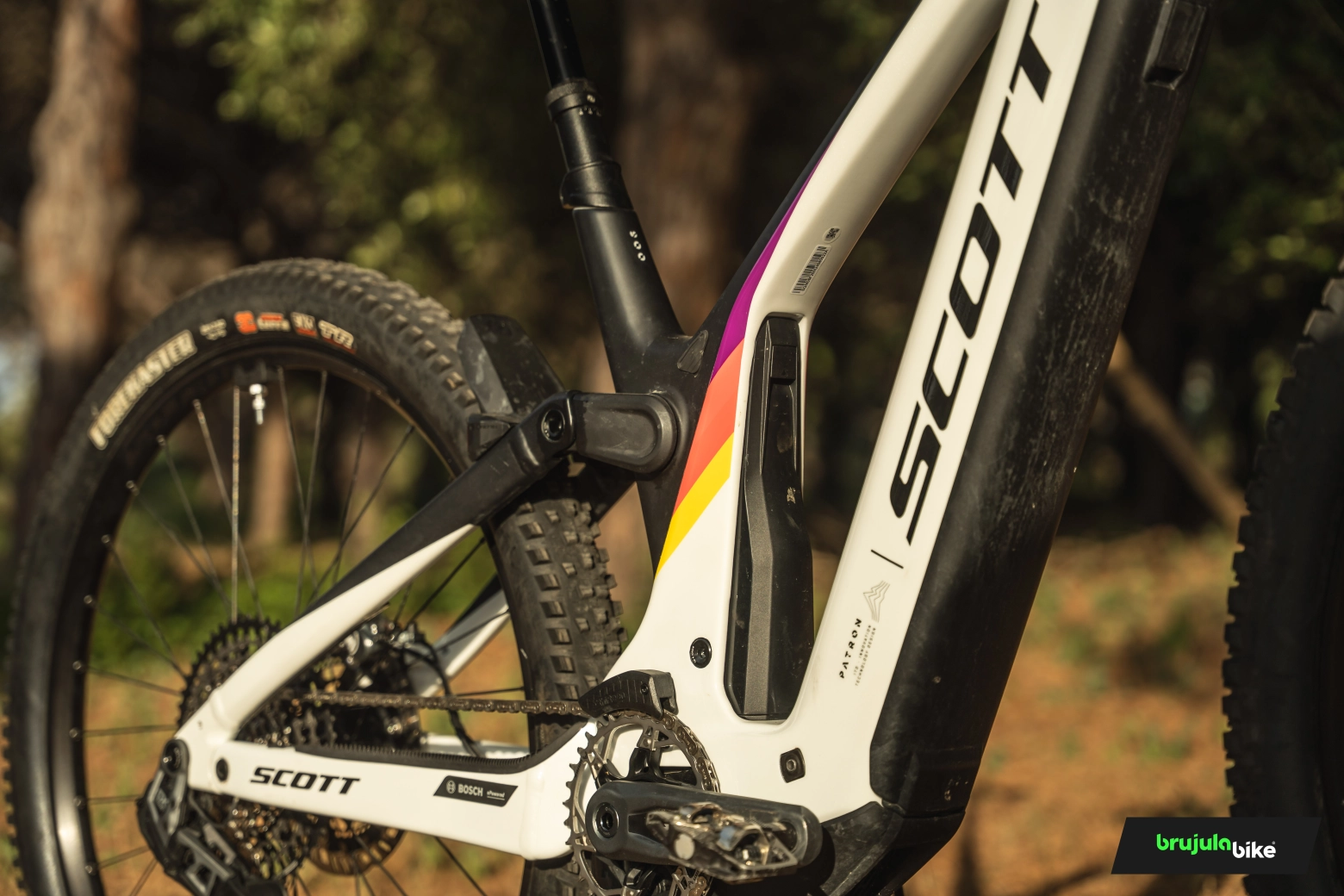
We know that Scott places great importance on the quality of these plastic covers, and it is clearly perceived in terms of ease of use and total absence of noise and vibrations.
At the pivot point of the link and on the left side of the frame, we find a guide that greatly facilitates the adjustment of sag and records the maximum sag reached by the shock absorber.
The Bosch Performance Line CX motor is now in a more natural position and is protected by another one of those plastic pieces that Scott works on like no other, achieving, with little weight, very high resistance. This protector has a grille in front to cool the motor itself.
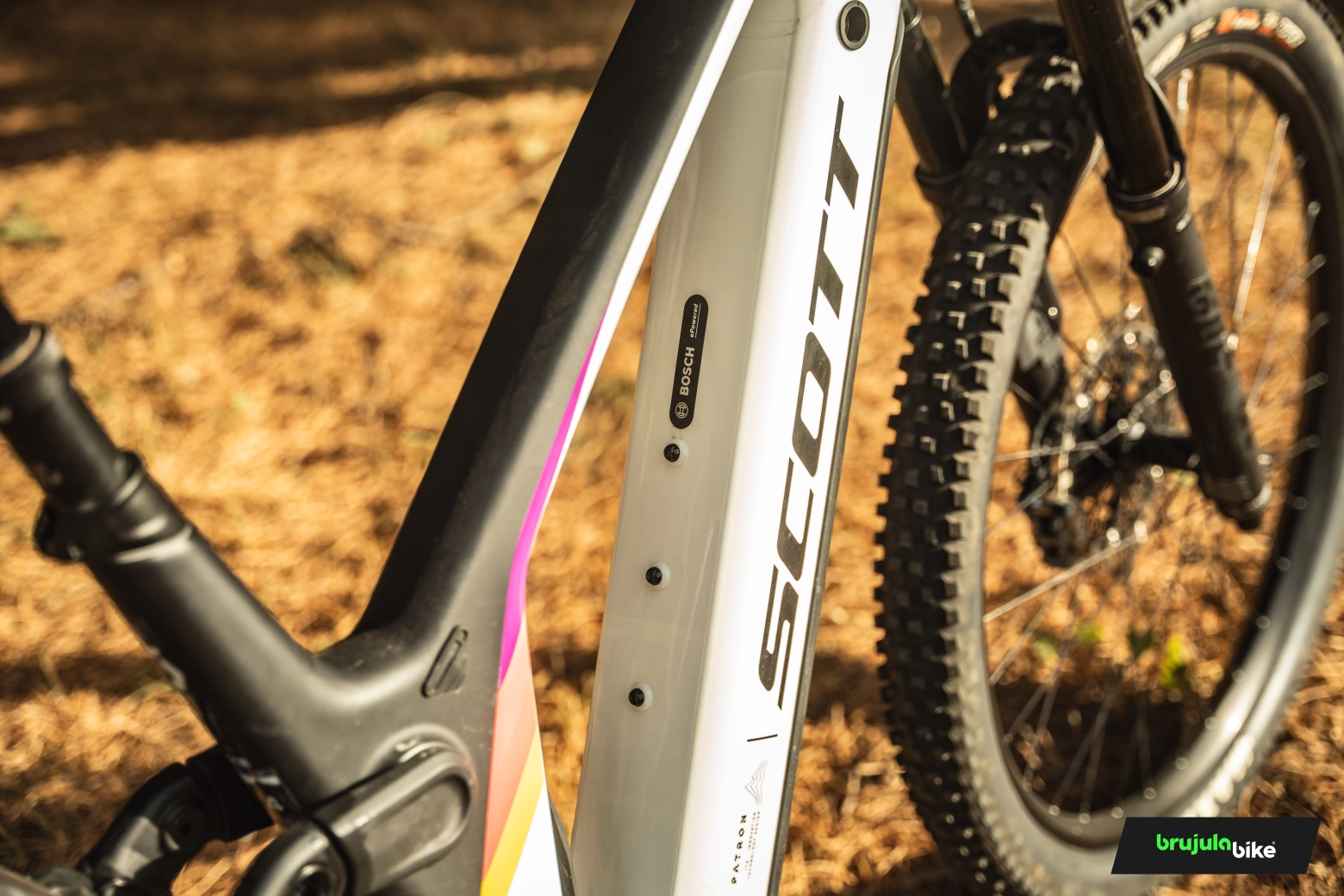
The battery occupies the inside of the diagonal tube, which is open at the bottom to allow it to be removed using a convenient, yet secure key system. Once again, we find a well-designed protector along this opening, which is very easy to remove and place back, and does not emit any noise or vibration while riding.
As we mentioned, the top tube has a marked inclination, seeking the lowest position to offer maximum freedom of movement. In this tube we find the Bosch System Controller, which shows us the necessary information through LED lights, but the tube comes with the space reserved for the new Kiox 400C display, recently introduced.
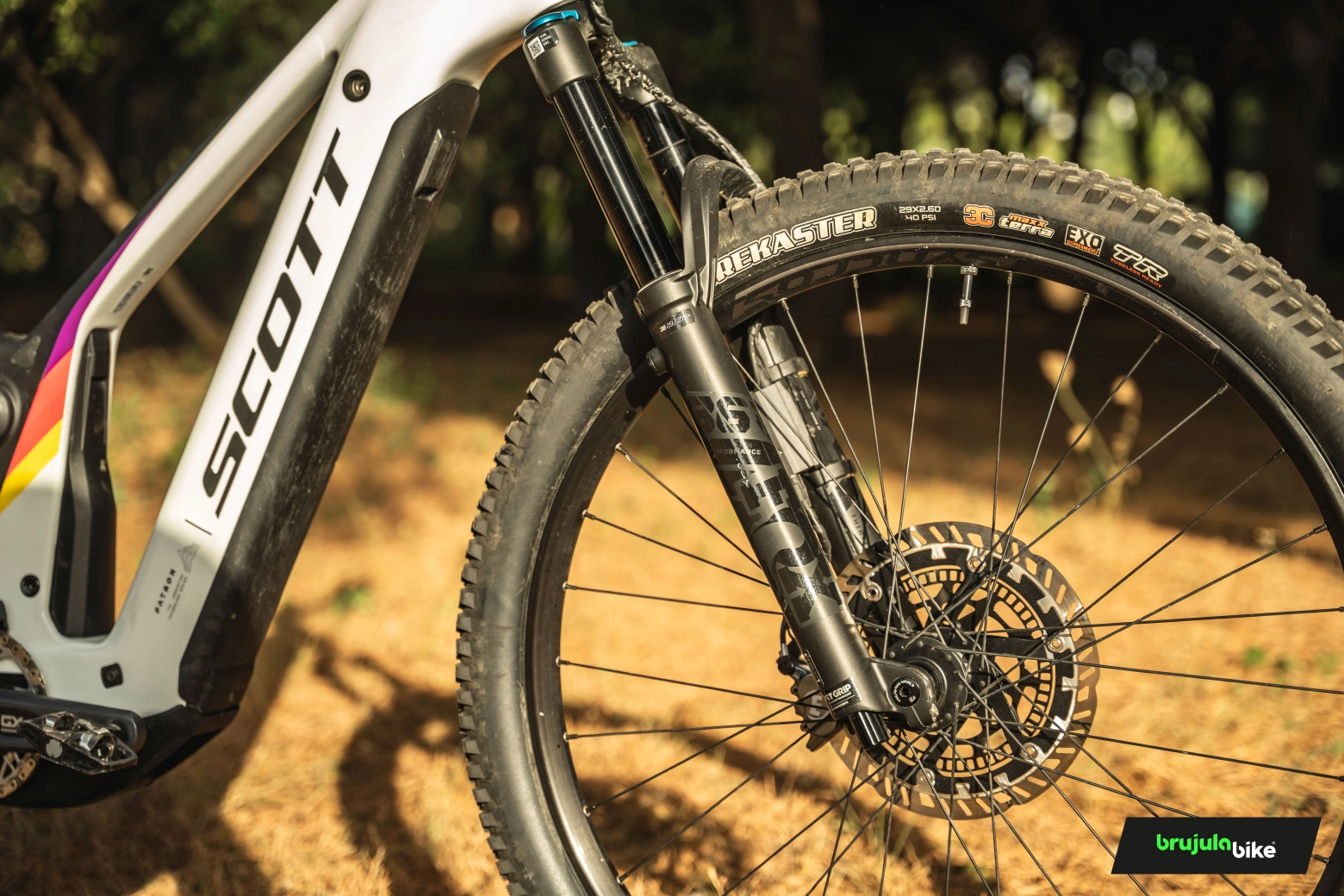
The swingarm, which in our test model is made of aluminum, has tremendously oversized chainstays and offers finishes at the level of the rest of the frame. A detail that follows Scott's integration line and that we liked a lot is the small rear fender with integrated lights, which can be turned on and off from the Bosch remote control.
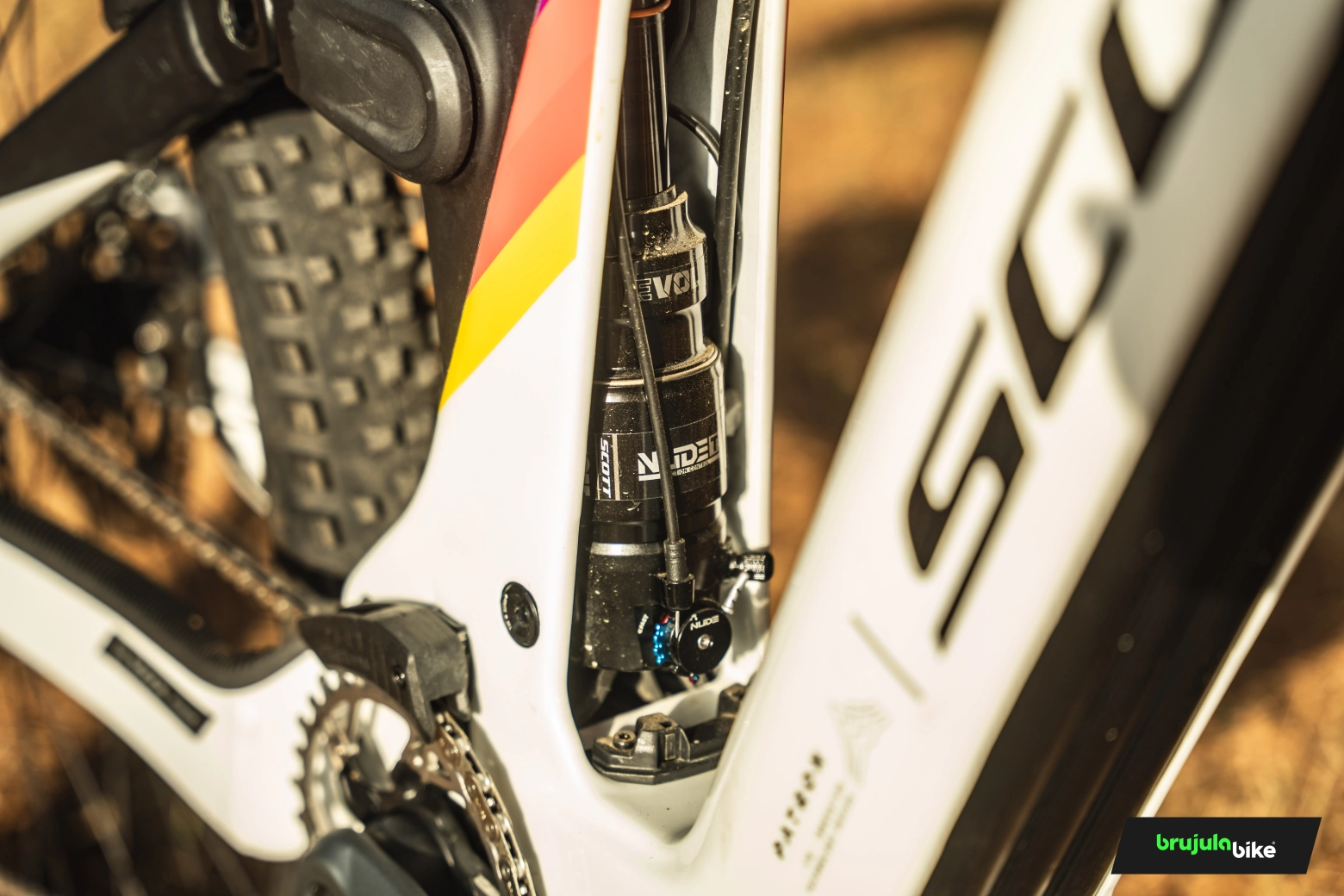
Regarding the geometry of the Scott Patron, we see that it does not vary greatly from the previous generation, especially in the standard version we tested, it has current but quite moderate numbers, in search of that versatility that allows it to maintain good agility.
The head angle is 65.8°, although it is adjustable as we will mention later. The seat angle is 77.2°, which positions us over the bottom bracket to favor climbs, as is the trend in this type of bikes. The reach of 459.3mm in size M is also very much in line with current numbers. The chainstays of 453.5mm are short enough considering it has 29" wheels and allows for generous volume tires, like the 2.6" it comes with. The rest of the measurements follow the trend, highlighting a somewhat generous Stack, of 647.4mm in size M, which will leave the handlebar quite high unless we remove the spacers.
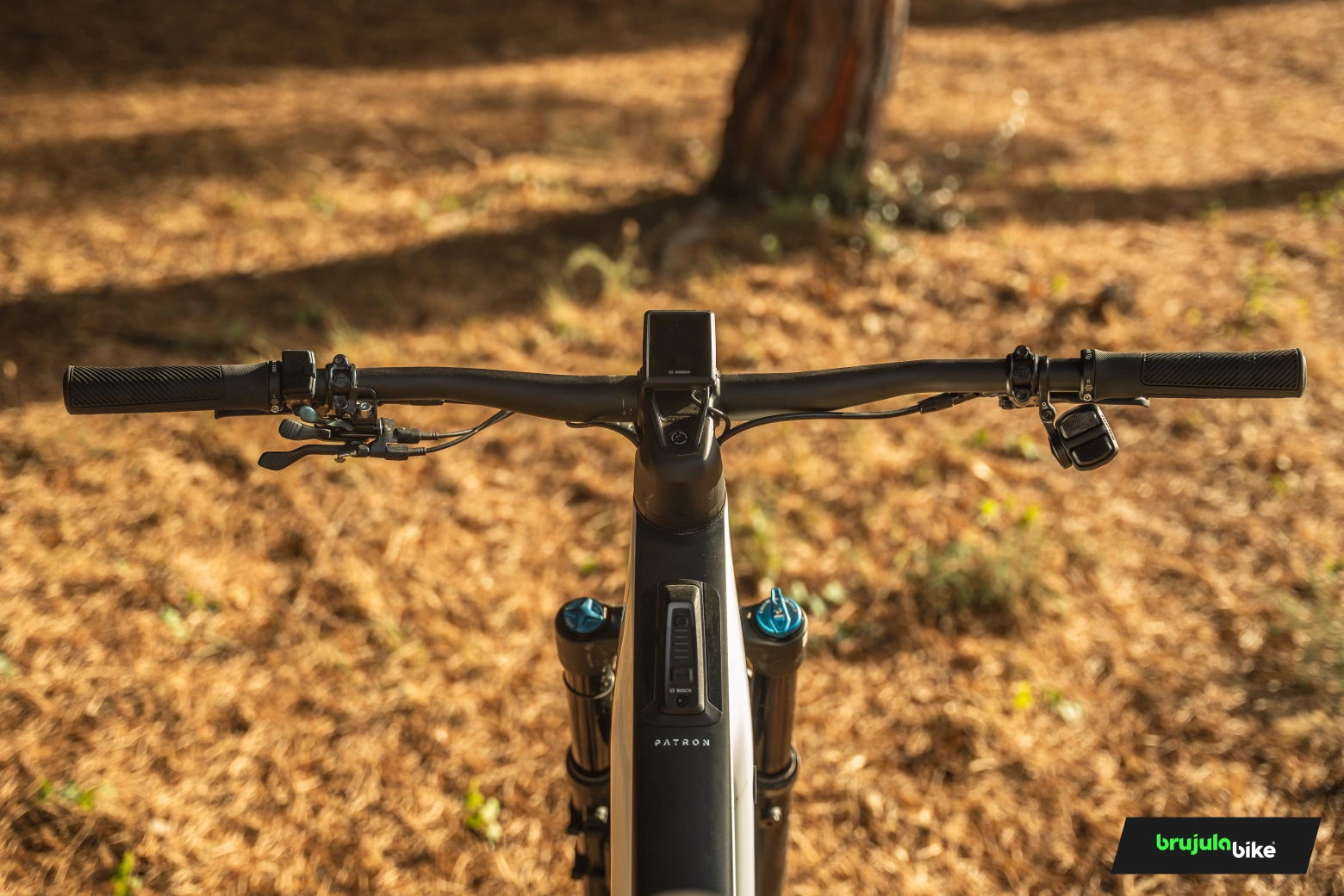
As we mentioned, the Patron allows us to vary the head angle if we mount the eccentric cups that the bike includes. The variation is -6° or -6°, so we can choose between the standard 65.8°, or 65.2° or 66.4°, depending on how we mount these cups.
The Bosch Performance Line CX Gen 5 is a safe bet for an ecosystem that continues to evolve
The Scott Patron mounts what is perhaps the most famous and most desired motor on the market. In its fifth generation, the Bosch Performance Line CX, received a significant improvement in sensors and firmware, achieving a much more natural response in assistance. The numbers, at first, did not change, with 85Nm of maximum torque. But evolution does not stop, and there is already an update that allows to release up to 100Nm of torque and 750W.
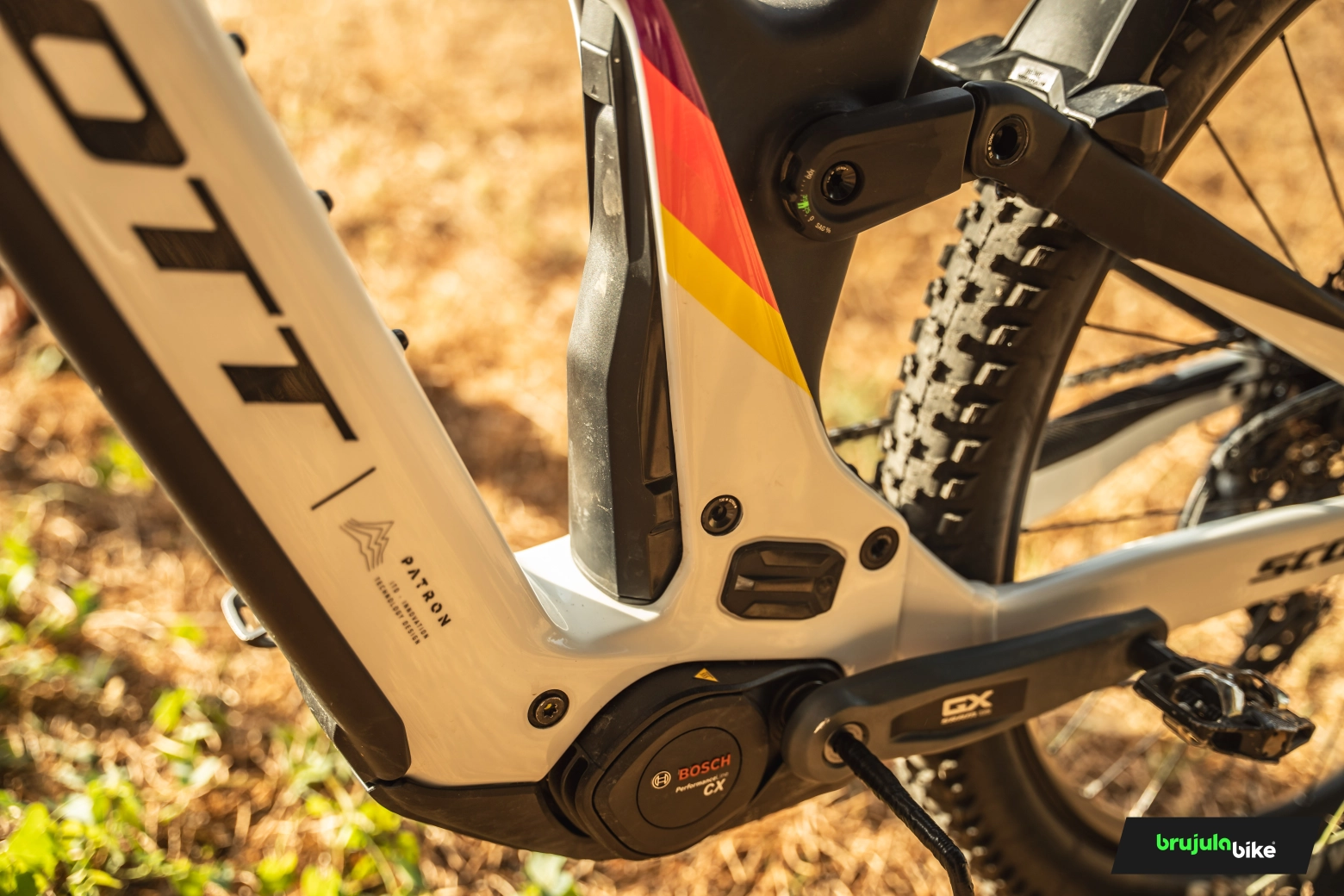
Our test bike, in addition to the 800Wh PowerTube battery, mounted the System Controller on the top tube, the wireless Mini Remote control on the handlebar, and also the Kiox 300 display on the stem.
But also, within the Bosch ecosystem, the Patron 900 mounts the Bosch ABS system.
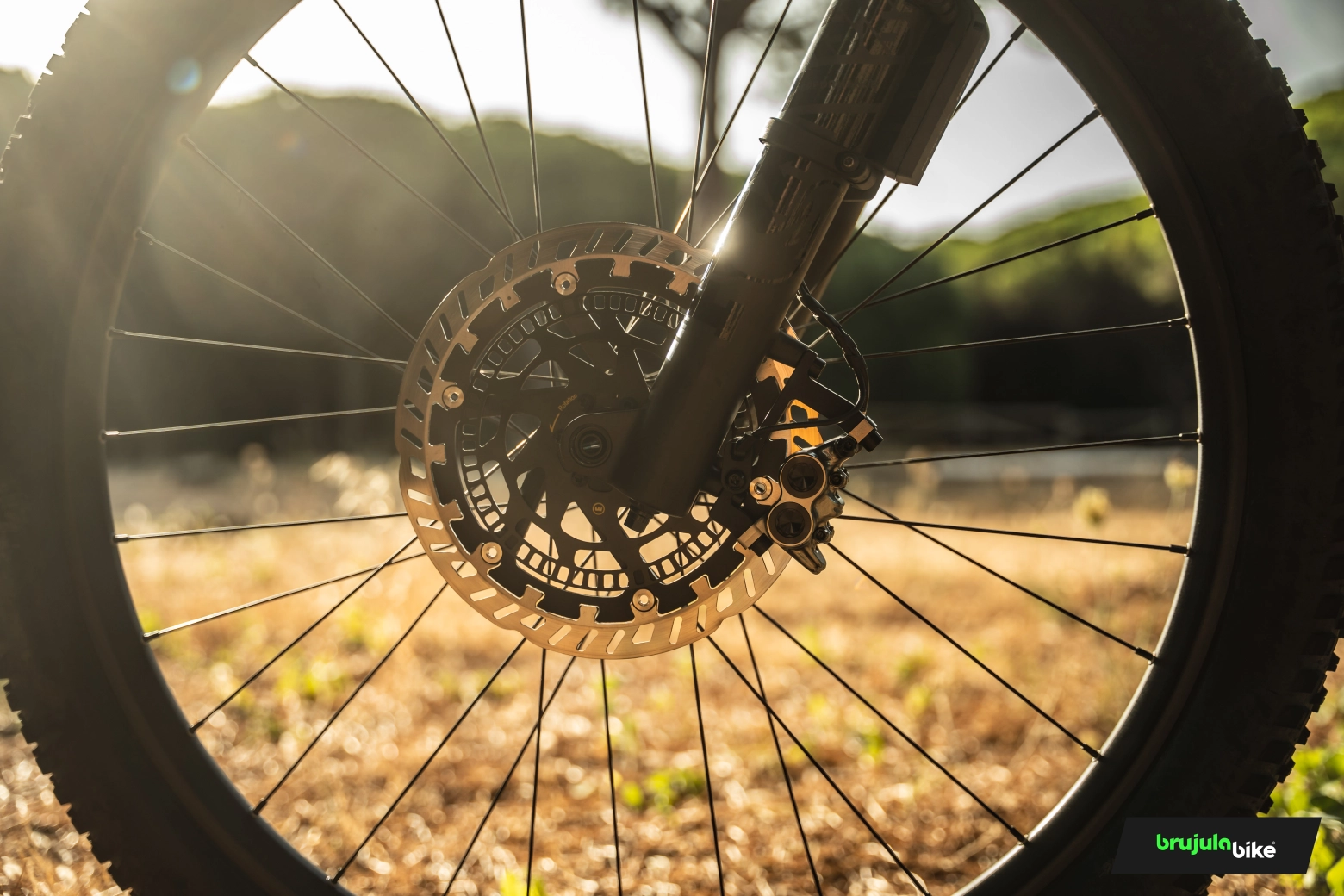
This system, which in our bike is coupled to powerful Magura MT7 brakes, reads speed data on both wheels, through an internal concentric disc for the ABS sensor, and also measures other parameters, such as inclination, etc. In this way, it can act in very specific moments to prevent the front wheel from locking, and even, depending on how it is configured, it can prevent the rear wheel from lifting during braking.
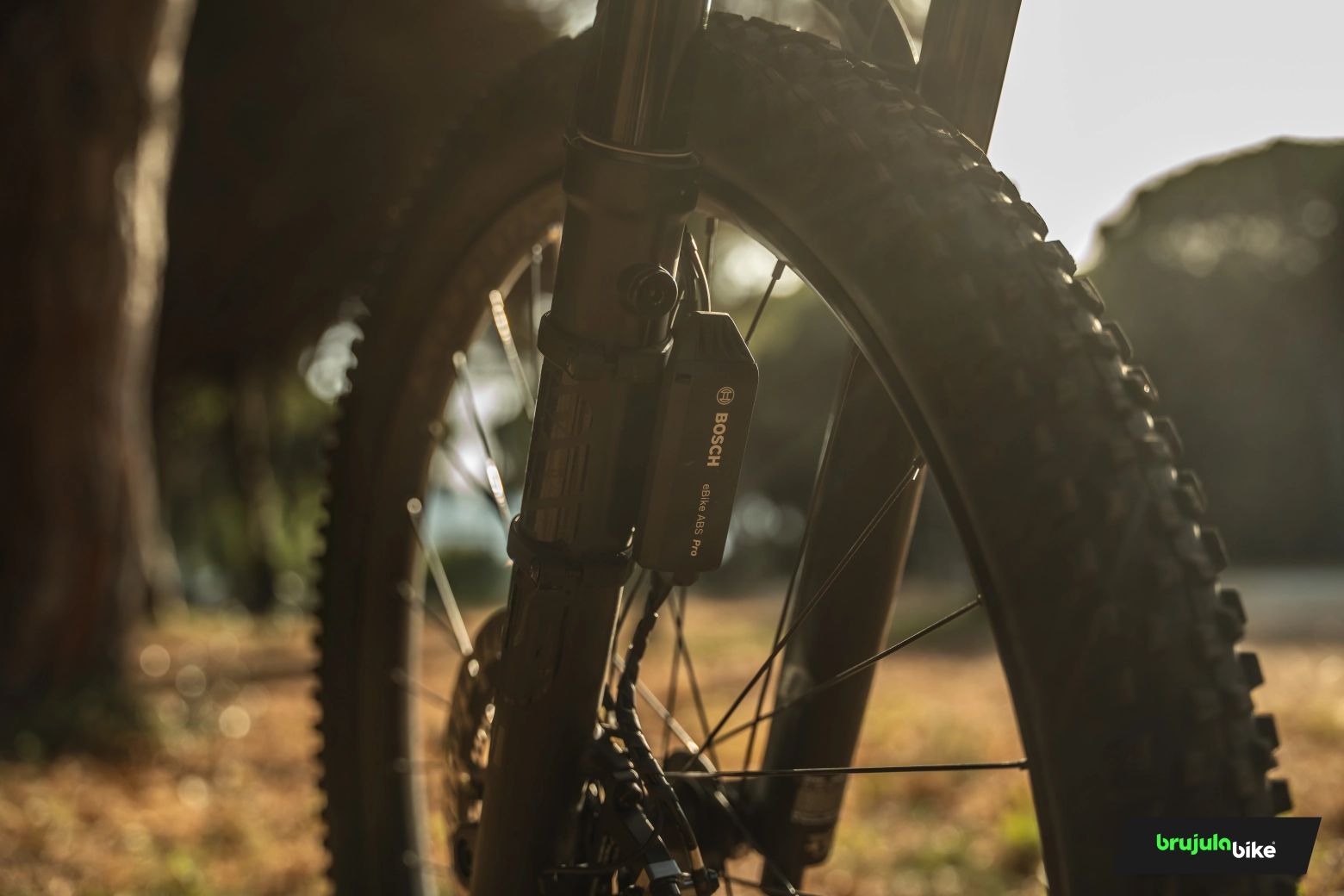
Riding with the Scott Patron 900
The Patron 900 we tested is the top of the range within the standard version of the Patron range.
In the Patron 900, a frame with a carbon front triangle and an aluminum swingarm are combined.
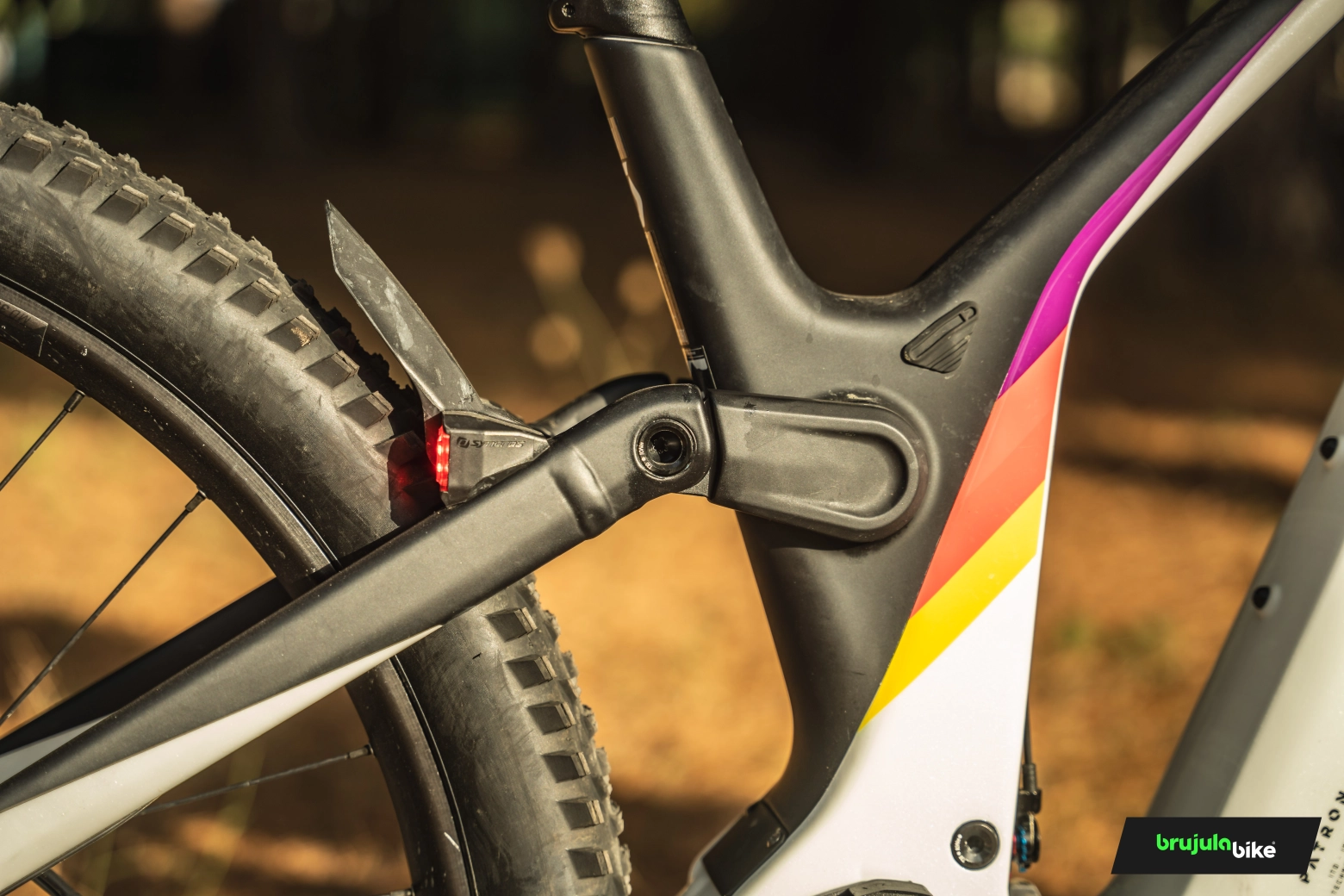
It is equipped with a Fox 36 Performance fork with 150mm of travel. The shock absorber, as usual in Scott, is customized for the brand, being a Fox NUDE 6T EVOL, with three operating positions controlled by the TracLoc 2 remote, which has a third lever for the seatpost.
The main peculiarity of this shock absorber is that in its intermediate position, an air chamber is closed and the travel is reduced, as well as the sag point, so that the geometry is slightly altered favoring climbs.
The transmission opts for the Sram GX Eagle AXS T-Type complete groupset, including specific eBike cranks. The brakes, as we have already mentioned, are the Magura MT7 with 220 and 203mm discs connected to the Bosch ABS system.
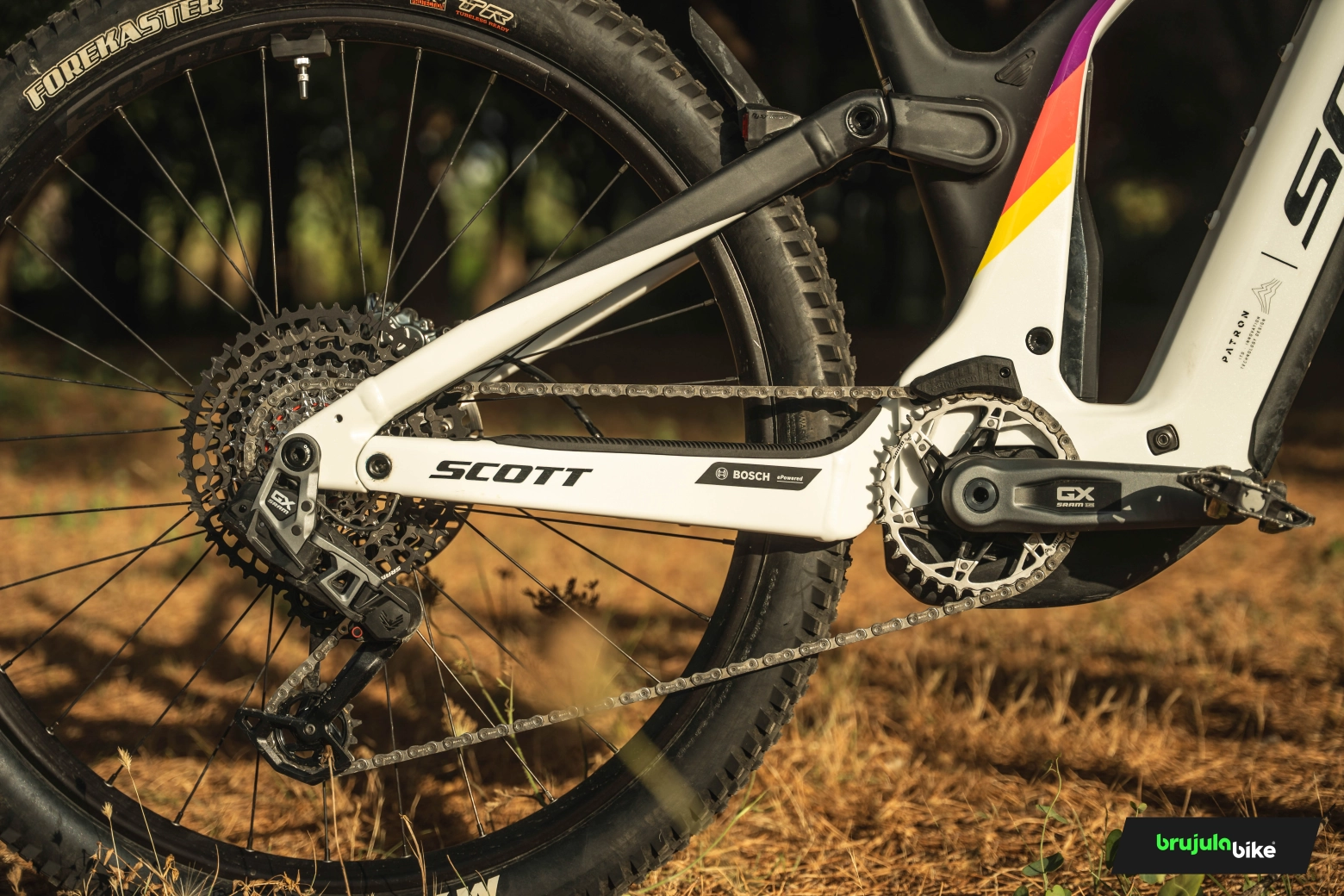
In the components, we find an aluminum Syncros handlebar and Syncros stem that plays an important role in the integration of the wiring towards the handlebar. The Syncros Duncan dropper post, 180mm in size M, has adjustable maximum extension to avoid possible limitations according to the rider's height. The saddle is also from the brand, with the Tofino-E 1.5 model.
The wheels combine Formula hubs with Syncros rims with 30mm internal width, and the tires it mounts are the Maxxis Forekaster in 2.6" width with EXO casing.

The truth is that the aesthetics of the Scott Patron 900 is one of the most striking and original. In person, those lines that we already clearly associate with Scott stand out a lot, from the integration of the stem with the handlebar to, of course, the central part of the frame, where the shock absorber is hidden from view. Also visually striking is how low its top tube reaches where it meets the seat tube, which, as we will mention, is noticeable in the freedom of movement it provides.
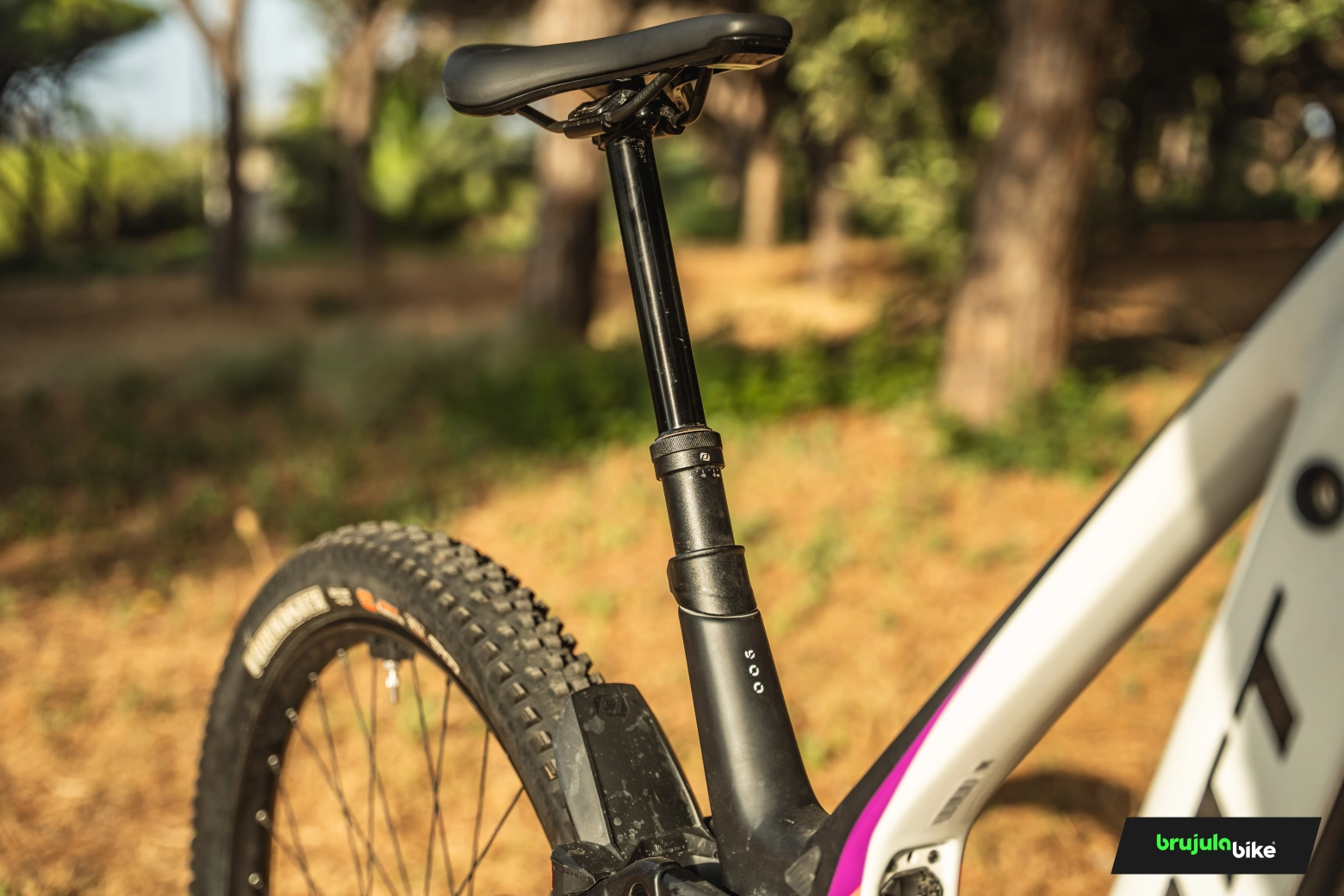
We weighed it before putting on the pedals and making adjustments. The figure it showed was 24.65kg. The truth is that considering that its assembly is not the most oversized (36 fork and not very reinforced tires), we find it somewhat heavy.

For adjusting the rear suspension, we have the invaluable help of the guide on the frame at the pivot point of the link. We get on the bike, place the indicator with our finger at the point that marks the sag, and get off. There is no need to measure anything or make calculations, as the graduated scale tells us exactly the percentage we are at. Once this is done, we set off.
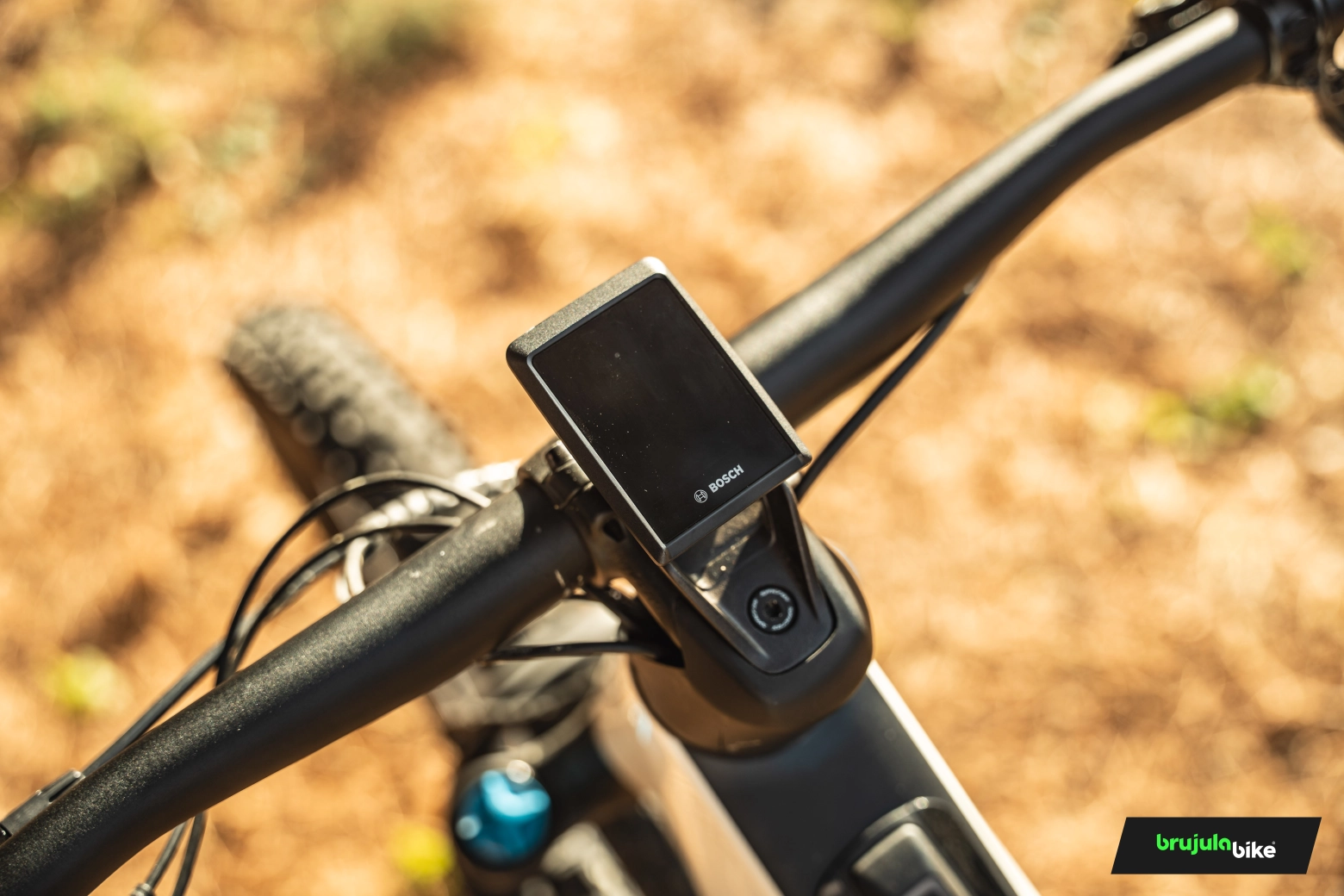
Normally, we focus the first kilometers on adapting to the motor's assistance and its different modes, but the truth is that we have already tested this new version of the Bosch motor on other bikes and we know it well.
As many of you may already know, the Bosch Performance CX is currently very configurable through the Bosch Flow App. While riding, we have 4 assistance modes, but these four modes can be chosen from a list that includes various standard and dynamic modes, such as ECO+, TOUR+, or eMTB. In our opinion, these dynamic modes offer a better user experience, as we feel the pedaling much more natural. Additionally, each of these modes has configuration margins, both in the amount of assistance and in the response at the beginning of pedaling, maximum torque, etc.
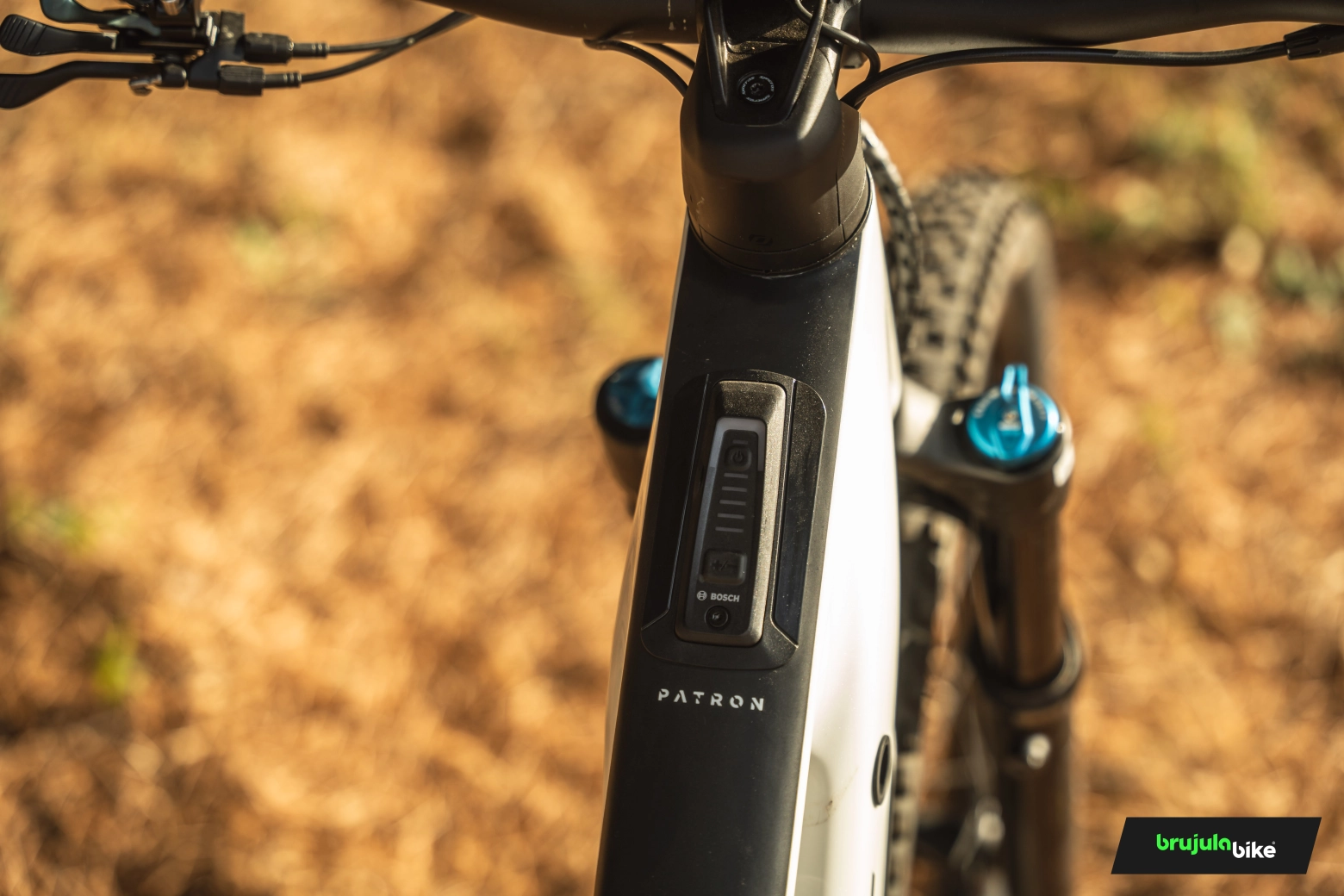
In the Patron, we have the particularity of mounting the Kiox 300 display. There are many bikes, especially enduro-specific ones, that do not mount a display, as with the System Controller on the frame we have the most relevant information through LED lights, but the display offers a much more complete user experience and those who like to have all the information will find it essential. In addition, the resolution is really good and can be clearly seen at a glance.
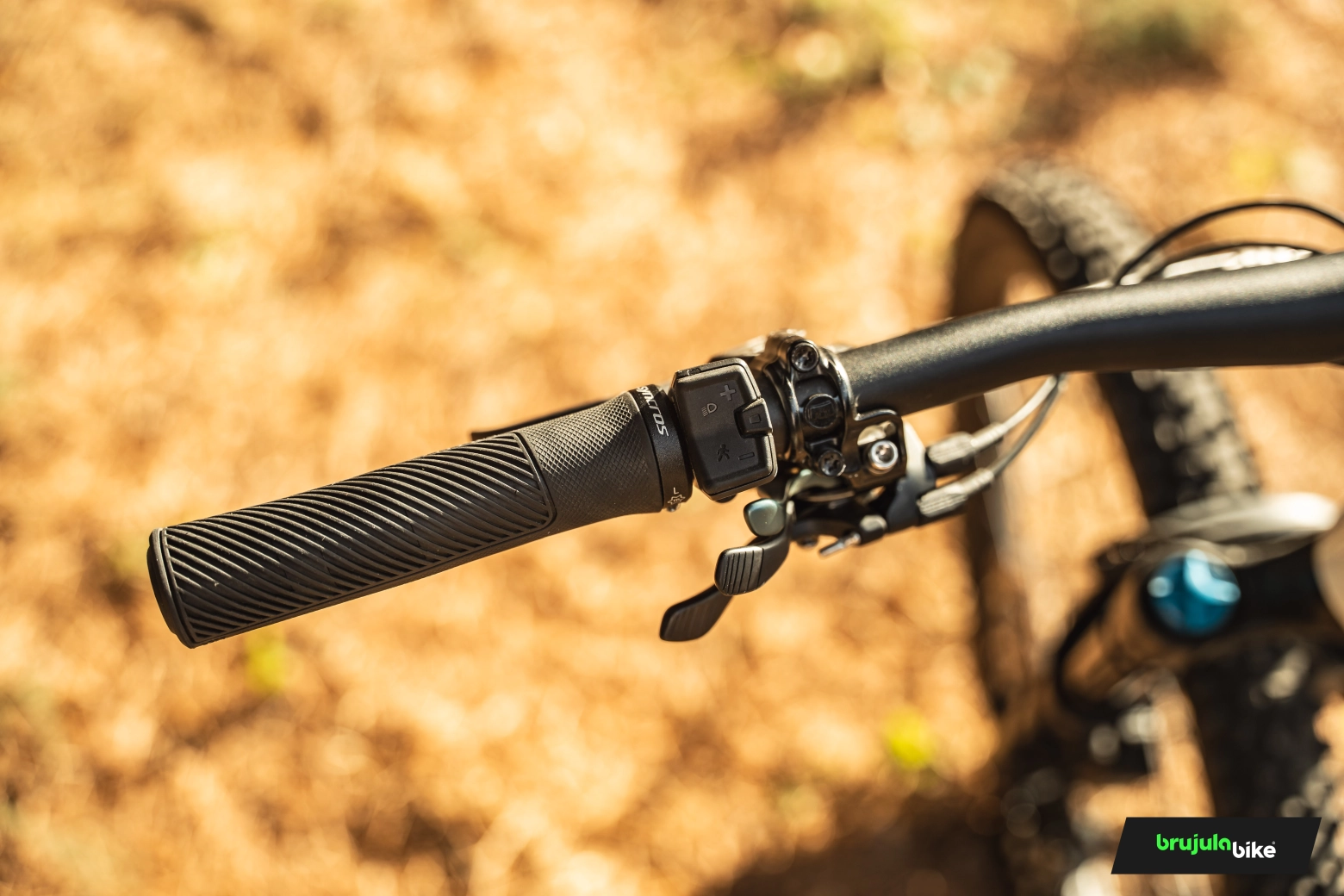
Both the assistance level and what we want to display on the screen are controlled with the Mini Remote control, which is totally ergonomic and easy to operate without having to look. The only drawback, to find some fault, is that it is so sensitive that sometimes we make involuntary presses when handling the bike.
The Scott Patron is one of those eBikes that, although focused on Trail, have in the ascents one of their strong points.
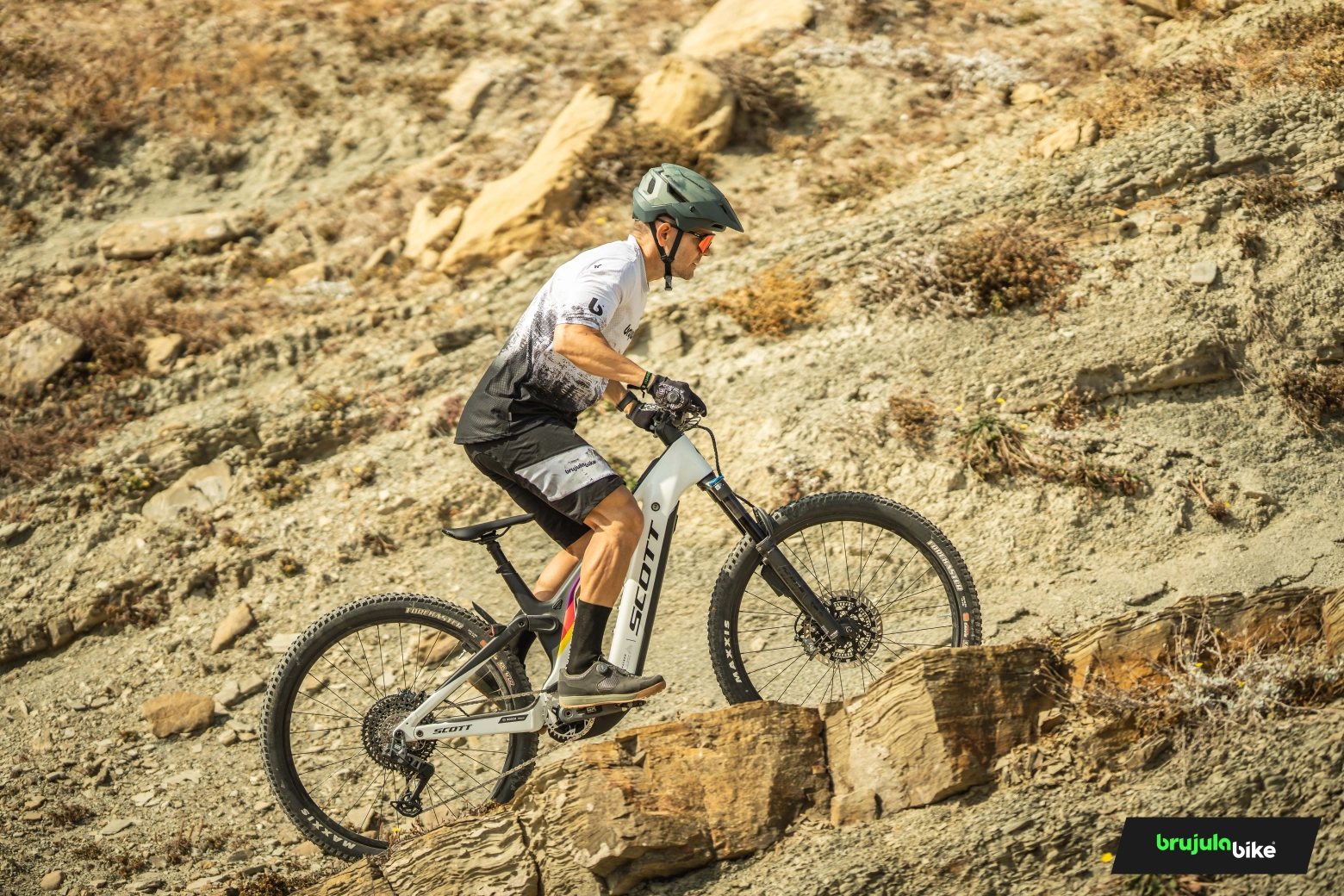
For starters, the latest generation of the Bosch Performance Line CX motor greatly increases its capacity on difficult climbs, not by an increase in power or maximum torque (which will arrive imminently, but in our tests the update was not yet available), but by better management of the assistance thanks to an improvement at the sensor level. Now the assistance is more controllable and in those very steep and bumpy sections we can use a high assistance without the bike tends to skid or get out of control.
On the other hand, the Patron has a geometry that makes it more versatile than other more radical bikes, so it retains a little more agility at low speeds, which allows us to easily take it along the right line on uphill trails.

And as a differentiating and already classic detail, when we talk about Scott, we have the TracLoc remote control and the NUDE shock. Although in an eBike the lockout is not so necessary, because the motor makes the power transmission to the rear wheel more constant, the truth is that we have it so handy with the remote control, that we ended up using it even to pedal standing up and change position on long climbs. But it is in the intermediate mode where the Patron has a great advantage, since apart from minimizing oscillations, by reducing the positive air chamber and reducing the total travel, it also slightly reduces the sag point, which places us more above the bottom bracket, favoring pedaling on climbs.
The Scott Patron is the total trail bike
In this type of bike, you're looking for good performance on all types of terrain, and the Patron has been put to the test on all our usual trails, from the easy ones to the ones where we usually take only the most downhill bikes.
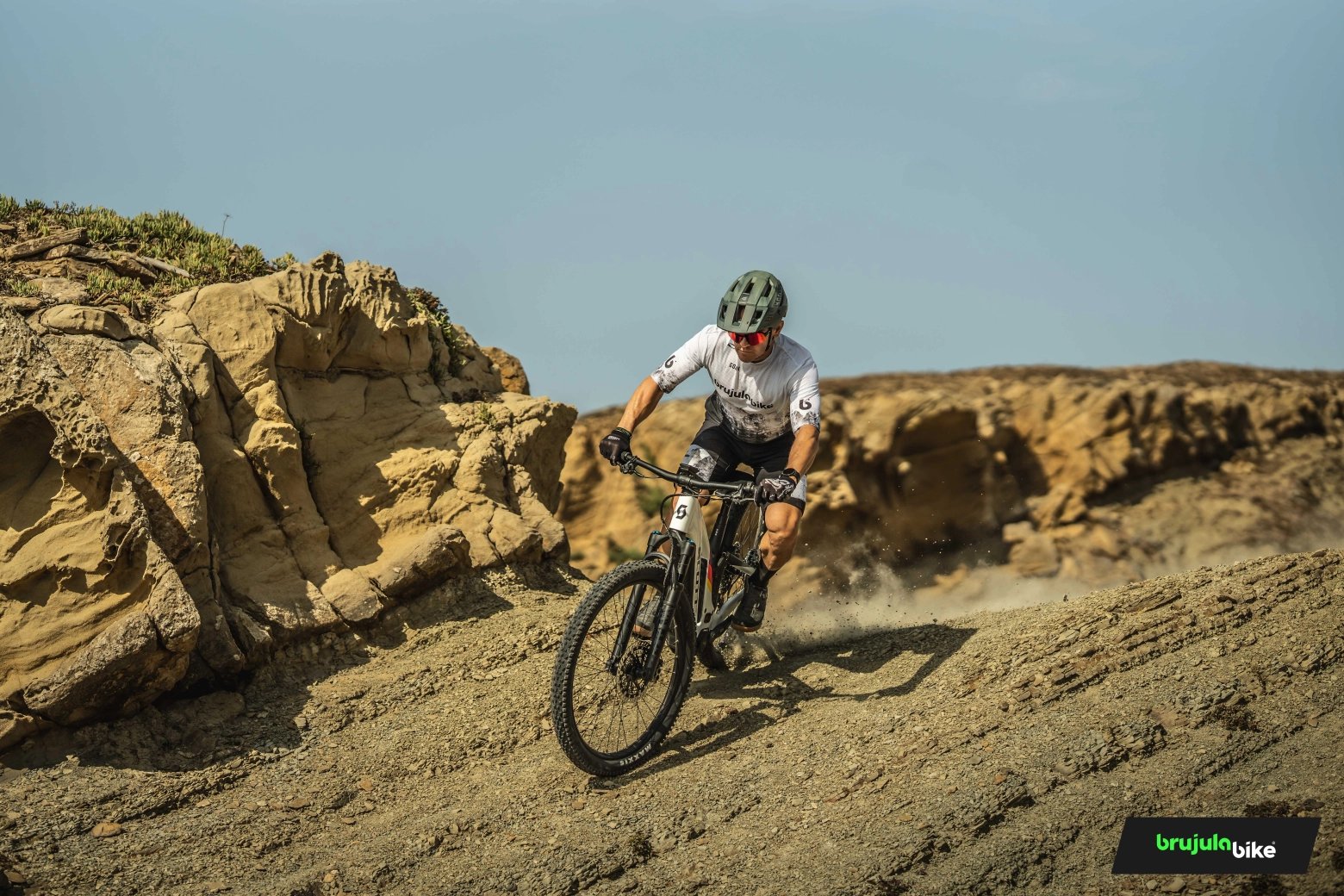
The first few days were spent in riding areas with lots of twisty turns. Here the Patron shows surprising agility despite not being a light bike. This is greatly influenced by its low center of gravity, which allows us to move the bike with ease.cIn these conditions we noticed how the tires are the biggest limitation when descending fast, as they do not have a sufficiently aggressive tread for some situations.
In this context we were able to check the operation of the ABS and we noticed how in terrain with little grip, and forcing the braking a little, it came into operation to prevent the front wheel from locking. We found it much less annoying than we expected, since the lever does not feel anything, we only noticed how the front wheel, with the loss of grip, slightly lengthens the braking and keeps the bike under control.
The truth is that an experienced rider does not usually have problems in this regard and we had to force the situation to test the system, but it is something that, after testing the bike for a long time, we see that it does not bother and is an insurance that is there for any unforeseen situation.
On our bike we had the option to configure the ABS in two modes via the App, called Trail Pro and Race and we only set it to Trail Pro mode to test it and check that it works by limiting the inverts at a certain speed, but we were using it the rest of the time in Race mode, where it only manages the front wheel locks.

We made, as we said, our forays into more technical and difficult trails, and here we were very pleasantly surprised by the Patron. Despite having a moderate 150mm of travel and a not overly relaxed geometry, it gave us a lot of security in the passage of bumpy and quite broken sections, showing a very balanced suspension performance. The feel of the rear is quite linear and the travel is easily exploited. The shock absorber, although in this version of the Patron is simple, without external reservoir, it has all the adjustments, including compression, to be able to tune it and leave it to our liking.
On these technical trails we also highlight the freedom of movement that the Patron allows, thanks to its low top tube.
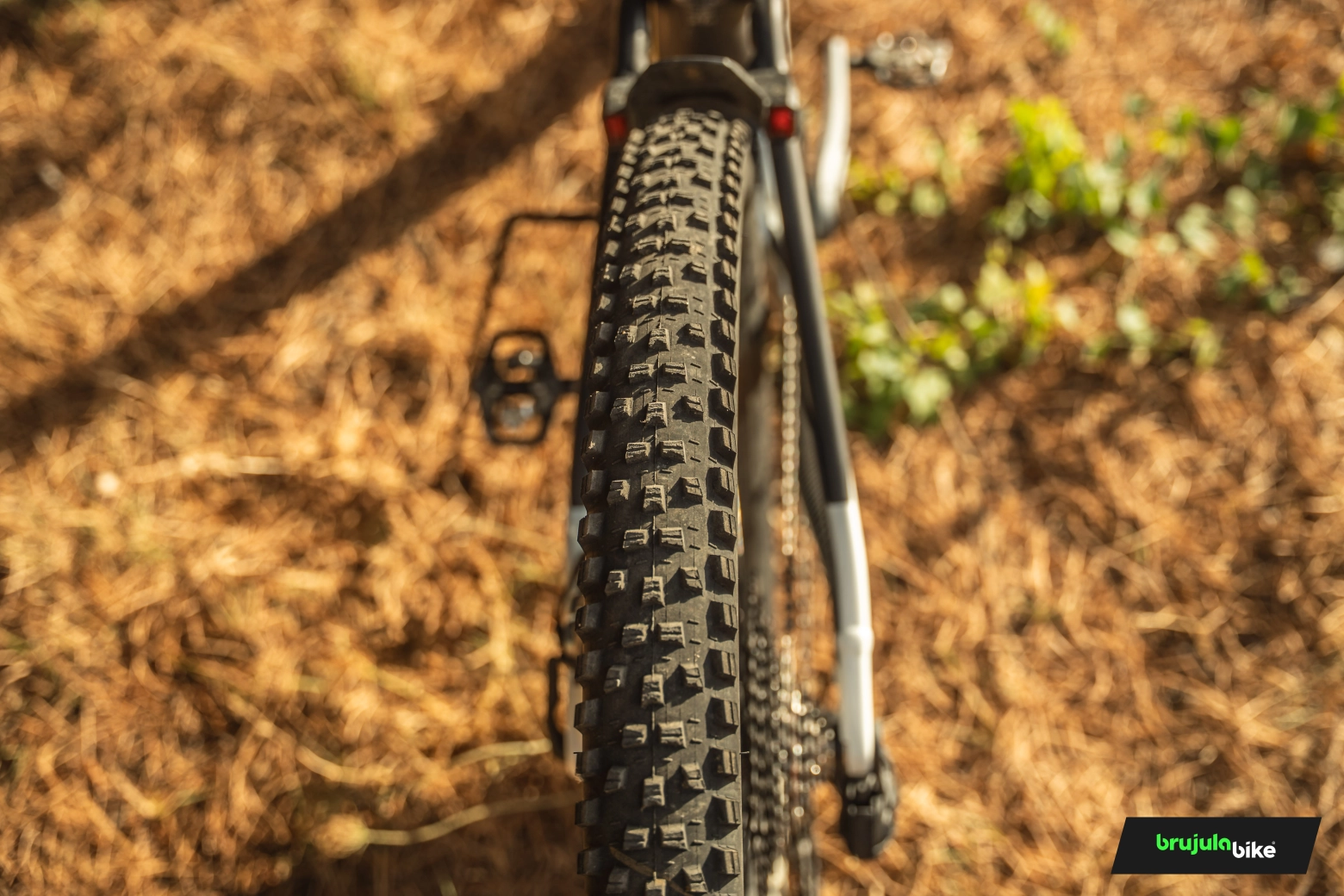
The only downside to the Patron 900's setup is the tires, as they limit the bike's real capacity. The Sram GX T-Type drivetrain once again performed flawlessly, and the Magura MT7 brakes, regardless of the inclusion of ABS, have plenty of power to keep a full-power eBike like this under control.
Conclusions
After the time we have had the Scott Patron 900 with us we can say that we think it is one of the most versatile eBikes on the market. In terms of riding position and pedaling efficiency it is ideal for long routes in which we will have a bike capable of facing any situation with guarantees. It also performs well in purely enduro terrain, although the user who has this use as a priority, has the perfect bike in the Patron ST versions.
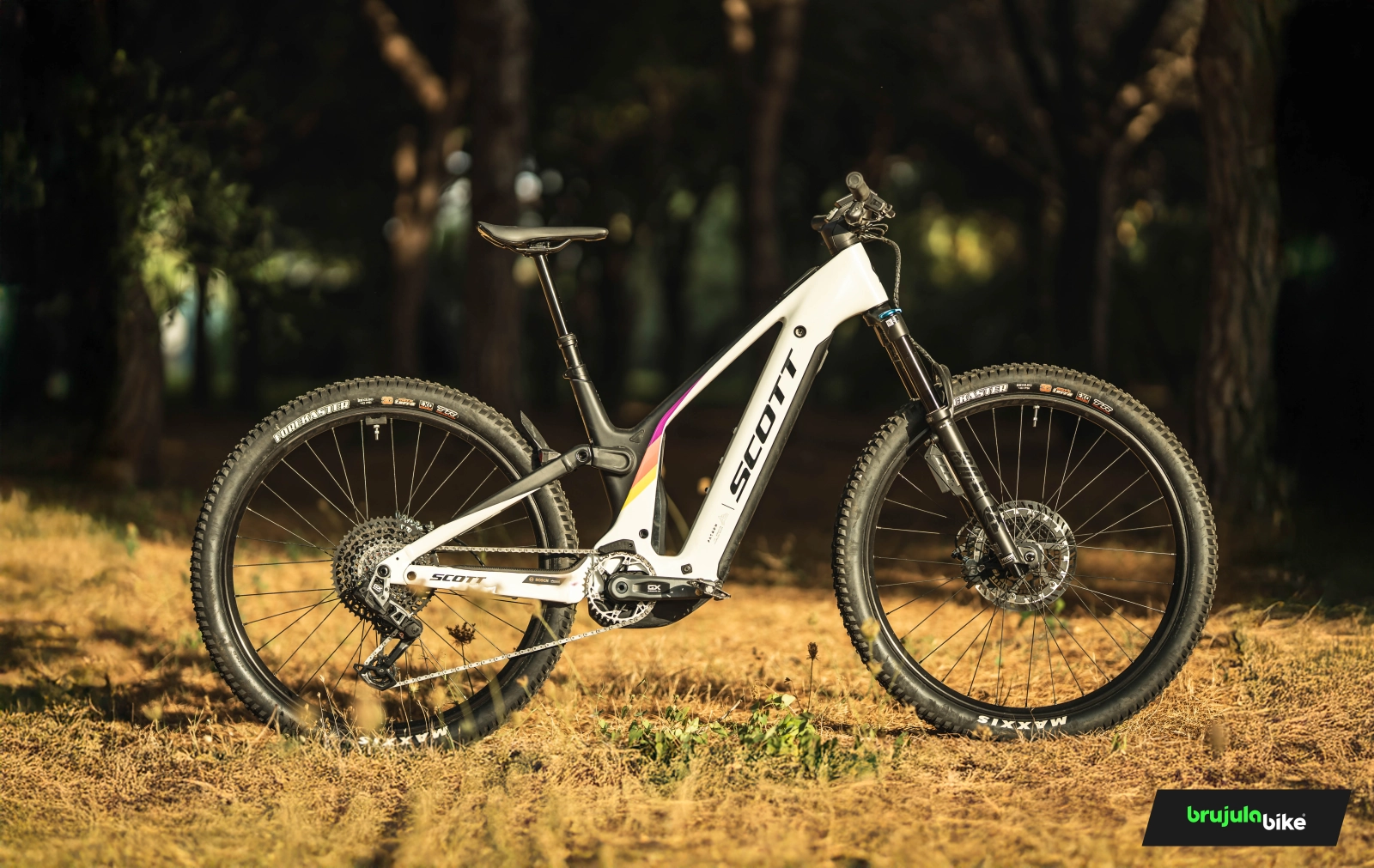
The Scott Patron range is presented in two versions, the standard Patron with three models and the Patron ST version with another three. The entry price to the range is €6,099 for the Patron 920. Our test unit is the top of the standard version with a price of €8,949. In the ST version there are more exclusive assemblies, the top of the range being the Patron ST 900 Tuned model which costs 11,199€.
Scott Patron 900: specifications, weight and price
- Frame: Patron Carbon main frame / Alloy SST-CST, 150mm
- Fork: Fox 36 Performance 150mm
- Shock: Fox NUDE 6T EVOL, 150-100-Lockout
- Motor: Bosch Performance Line CX
- Battery: Bosch PowerTube 800Wh
- Display: Bosch System Controller, Mini Remote and Kiox 300
- Rear derailleur: Sram GX Eagle AXS T-Type
- Shifter: Sram Pod Controller
- Cranks: Sram GX Eagle, 34T
- Chain: Sram GX T-Type
- Cassette: Sram GX Eagle 1275, 10-52
- Brakes: Magura MT7 / Bosch ABS Pro, 220 / 203mm discs
- Handlebar: Syncros Hixon 1.5 Alloy
- Stem: Syncros AM 1.5
- Seatpost: Syncros Duncan 1.5S, travel adjust, S 140mm / M 180mm / L 180mm / XL 210mm
- Saddle: Syncros Tofino-E 1.5, titanium rails
- Hubs: Formula DC-711 / EHT-1481
- Wheels: Syncros MD30
- Tires: Maxxis Forekaster 29x2.6”, EXO / TR / 3C MaxxTerra
- Weight: 24,65kg
- Price: 8.949€
Here you can take a look at the full range of the SCOTT Patron 2025 and on the official SCOTT website you can check out the frames and other models of the brand's eMTB range.